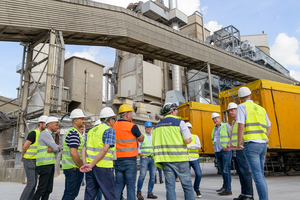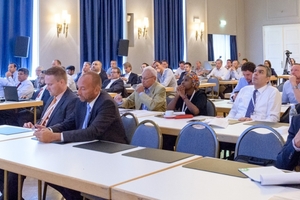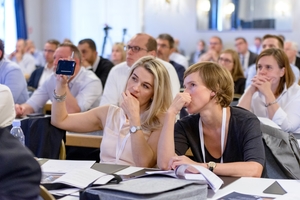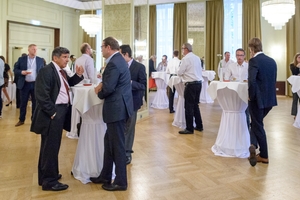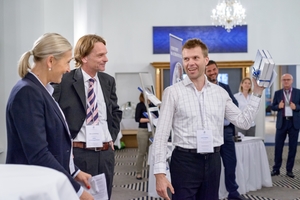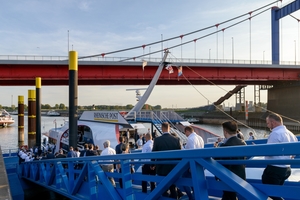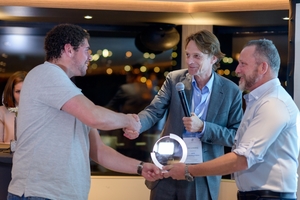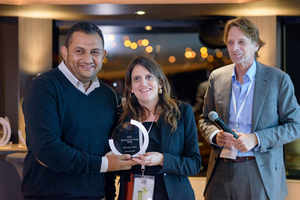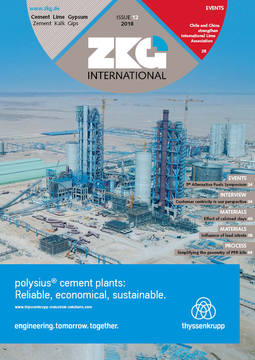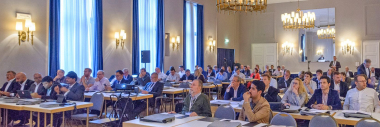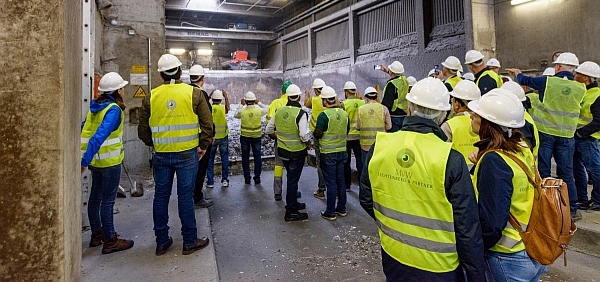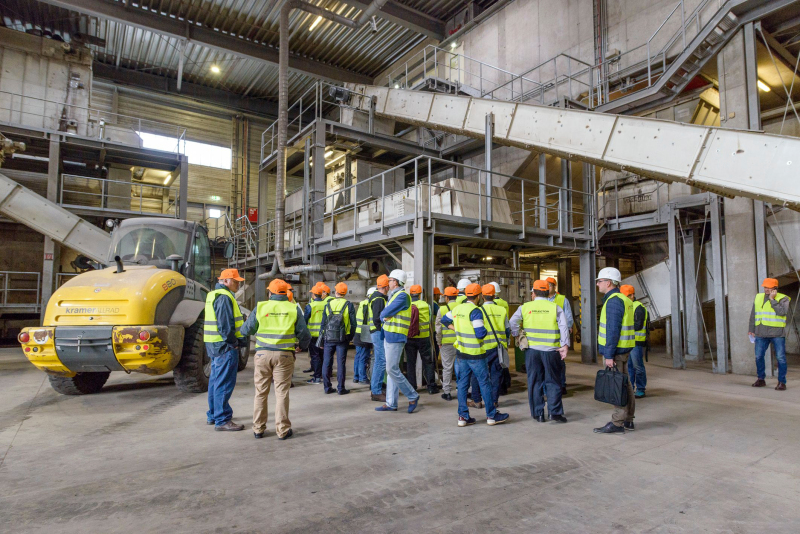5th Alternative Fuels Symposium with attendees from 32 countries
More than 140 attendees met from 19.09.–21.09.2018 for the 5th Alternative Fuels Symposium in Duisburg, organized by MVW Lechtenberg & Partner. On the first day, the programme included a visit to a processing unit for substitute fuels at the Dyckerhoff cement plant in Geseke. Over the next two days, the experts discussed alternative fuels, their processing and use in the cement industry.
1 Innovative processing system for substitute fuels
This year’s excursion on Wednesday afternoon took the group to the Dyckerhoff cement plant in Geseke, which, with its 52 employees, produces four types of cement and supplies up to 380 000 t cement annually.
The plant has long been using secondary fuels and has set itself the goal of utilizing more than 90 % alternative fuels. In the last few years, investment has therefore been made in equipment for processing secondary fuels. In 2010, a fine milll for fluff preparation for € 2.2 million was installed, followed in 2011 by a chlorine bypass system for € 3.3 million. In 2017, investment was made in a secondary fuel unit (€ 2.3 million), which the group also viewed. At the time of the visit, a DeCONOx plant was under construction, once this has been put into operation, the percentage of secondary fuels used is to be increased further.
Following a short overview of the plant control room, which is operated by only one employee, the group viewed a simple technology that can be used on all delivered substitute fuels to reduce impurities. The plant is installed as an online processing unit prior to kiln firing. The substitute fuel delivered on a walking floor truck trailer is fed continuously to a receiving and metering station and then loosened up. By means of conveying and weighing systems, it is fed pneumatically to the SI-TRO-ZER machine. Here, in a continuous material stream, impurities are removed from the flow of substitute fuel, and at the same time, the material is dried with the waste air diverted from the clinker cooler and comminuted to the required particle size in the rising entrained flow. The processed substitute fuel is then conveyed pneumatically to the kiln firing. The removed impurities are collected and disposed of. The drive power of this unit is 110 kW, the feed rate 6 t/h, the speed is infinitely adjustable.
The attendees not only had the opportunity to take a close look at the unit, they were able to find out all the details from the representatives and discuss with the employees of the cement plant their experience with the unit.
2 Alternative fuels – their processing and possibilities for use
Dirk Lechtenberg, MVW Lechtenberg & Partner, was delighted to welcome more than 140 attendees from 32 countries to the symposium.
The organizers had selected 20 presentations all about the use of alternative fuels: case studies, country and regional reports, new technologies for the use and production of alternative fuels. Lechtenberg emphasized the importance of the use of alternative fuels in respect of CO2 reduction in the cement industry. An important role is played by China, which is responsible for more than half of worldwide cement production and accordingly the related CO2 emissions.
An “Aumund integrated solution for optimization of alternative fuels application in cement plants” was presented by Dr. Rainer Bertling, Aumund Fördertechnik. Key feature of this solution is its high flexibility. With reference to the example of a solution implemented for Märker Zement, Bertling pointed out the advantages of the system, like, for instance: no deep pits, flexibility of location, buffer holding capacity, controlled rate feeding, reduced dust generation and energy consumption, and easy maintenance access. Bertling also discussed an integrated approach for the handling and treatment of AF centring around a unique processing step, the V-Mill (or Si-Tro-Zer), developed with a cooperation partner. With this new technology, RDF can be dried from 30 % moisture down to < 10 % and at the same time the input grain size comminuted from 30 – 60 mm to the final grain size of < 10 mm – all in one step: classifying, drying and comminution.
“Innovative technologies for RDF production & handling” was the subject addressed by Tim Hamer, Vecoplan. He reported on a high-performance SRF handling plant for Irish Cement with a conveying capacity of 840 t/d and a storage volume of 5 000 m³ on the smallest possible area and with energy-efficient transport over long conveying distances. The plant started up in 2013 and was upgraded in 2017. The delivered materials are stored in various storage facilities to produce a material blend in different grades: RDF material for the pre-heater with a size < 80 mm and for the main burner with < 30 mm. He then presented the new VEZ 3200, launched in 2018, a single-shaft pre-shredder with high throughput capacity.
Fritz Driesler, Lindner-Recyclingtech, presented a “Case study for the production of alternative fuel from solid waste for the cement industry”. He profiled a project in Mexico, in this country around 56 million t/a waste is produced that differs regionally and has a high organic content and high moisture. In the project described, RDF is produced for the pre-calciner. Installed was a one-step-shredder, boasting high availability and low maintenance. The average throughput rate is around 16.7 t/h, 80 % being comminuted to smaller than 30 mm.
In other papers, various possibilities for the production of alternative fuels were presented with reference to numerous case studies. The universal goal is to avoid landfilling waste but rather to feed it to a modern waste treatment facility. Companies such as Metso, DI Matteo Förderanlagen, Schenck Process, FLSmidth Pfister and Loesche informed the attendees about their solutions for the processing and use of alternative fuels in the cement industry.
“Waste management in selected countries in the Middle East and Africa – opportunities and business models for alternative fuels” was the subject addressed by Bassam Moumneh, Averda International. He showed, for instance, the big differences in waste on global scale. While the per capita production of waste in Europe is 1.34 kg/d and in the USA even 2.13 kg/d, in Africa it is only 0.78 kg/d and in the Middle East 1.9 kg/d, although with an upwards trend. In landfilling, too, there are great differences: with 26 %, the least waste is landfilled in Europe, the USA reaches 56 %. In Africa (96 %) and ME (91 %), almost the entire waste is landfilled. Accordingly low are also applications in waste to energy (1 %), while in Europe these reach 28 % and in the USA 13 %. These differences must be taken into account, when a project is planned in the different regions.
Boris Hille, Process Sensors Europe presented an “Automatic moisture control for refuse-derived fuels” and informed attendees about the possibilities for measuring moisture at different points in the process.
3 Case studies at cement plants
On the second day of the symposium, attendees from cement plants discussed their practical experience with alternative fuels.
Rick Bohan, Portland Cement Association, spoke on the US American cement industry and the “Development of alternative fuels in the United States of America”. The 91 US American cement plants – seven are wet plants and 84 dry plants – operate 128 kilns. The US cement capacity totals 96 million t/a, the annual cement production reached only 85.4 million t in 2016. 72 % of the US cement capacity was built after 1980, the average age of the kilns is 34 years. The use of alternative fuels is regulated by three primary permits and the list of permitted materials is not long. 73 % of the US-American cement plants use waste fuels: tyre-derived fuel (40), waste oil fuel (15), solvents (11) and others (62). Bohan assumes that the use of waste-derived fuels will increase further in the USA.
“The role of the cement industry in a sustainable waste management in the Kingdom of Saudi Arabia – constraints and opportunities” was presented by Saleh Al Shabnan, City Cement. The cement industry is spread relatively evenly over the whole of Saudi Arabia and produced around 50 million t in 2017, although production capacity, however, is 84 million t. There are opportunities for the use of alternative fuels. The national waste management strategy is under approval, a large amount of high-quality waste with RDF fraction of well over 40 % and also a good quality agricultural waste are available. In order to use alternative fuels, substantial investments are necessary as the cement plants are not yet designed to handle them. City Cement is engaged in the use of alternative fuel and has increased its AF substitution rate from 5 % in 2005 to 25 % in 2018. For the year 2020, 50 % is planned. City Cement uses old tyres and has invested in equipment for processing these. A second focus is waste heat recovery. City Cement’s waste heat recovery (WHR) unit was started up in 2015. The WHR unit produces 14.25 MW. The use of solar energy is a third focus.
Berthold Kren, Geocycle Asia, GM – Geocycle India, reported on his experiences in the region: “Development of alternative fuels in the APAC region – case studies of Geocycle”. He summed up his conclusion as follows: “AFR is still a clearly underdeveloped sector in APAC region, which is quickly picking up in line with public awareness. Whilst the idea of co-processing is widespread and understood already, the execution of the law and the administration of the regulations is one of the biggest problems. These regulations partially allow utilization at different maturity states in the countries mentioned. The quality and composition of the AF mix is very different to the EU: Common AF like waste tyres or specific industrial wastes cannot be found in APAC on a broad scale. The MSW contains more than 50 % organic material and the RDF usually has 35 – 45 % moisture and an NCV of about 2 500 kcal/kg. The biggest growth potential for AFR in the region is certainly RDF generated from MSW. The low landfilling benchmark hinders this development.”
The “Alternative fuel dryer project at Souselas Plant” was the topic of Sandro Conceicao, Intercement. Intercement produces at plants in Europe, Africa and South America. The Souselas plant in Portugal has, since 2012, an RDF installation to feed RDF to the precalciner and main burner. The thermal substitution rate rose from 4.2 % in 2012 to 23.9 % in 2015. As the municipal solid waste has a moisture content of around 40 %, the company invested in a dryer for the RDF for the main burner, in which the fuel is dried down to 15 % moisture content. The modular design of the plant made its installation easy. A fully automatic process control and low maintenance requirements are key features of the dryer, it is suitable for various types of waste. The average dwell time in the dryer can be adjusted to between 6 and 30 min. The RDF throughflow rate is 10 t/h at the dryer entrance and 7 t/h at the dryer exit. Since its start-up in 2017, already 40 000 t RDF have been dried.
With two more case studies from South Africa and Egypt, the programme of talks at the 5th Alternative Fuels Symposium in Duisburg was concluded.
4 Alternative Fuel Award
This year, the winners of the “Alternative Fuel Award” were presented at the dinner on Thursday evening on a Rhine ship. The winners were:
1. Reliance Investment & Project Management, Egypt
2. Cimpor, part of Intercement Group, Portugal (Souselas plant)
3. Interwaste, South Africa
Two honorary awards went to Quena Cement, Al Nahda Industries, Egypt, Mohammed Hamada Ali Ahmed, and to Bio Energy, Egypt. The evening on the excursion ship on the Rhine offered ample opportunities for the attendees to share experiences.
//www.lechtenberg-partner.de" target="_blank" >www.lechtenberg-partner.de:www.lechtenberg-partner.de

